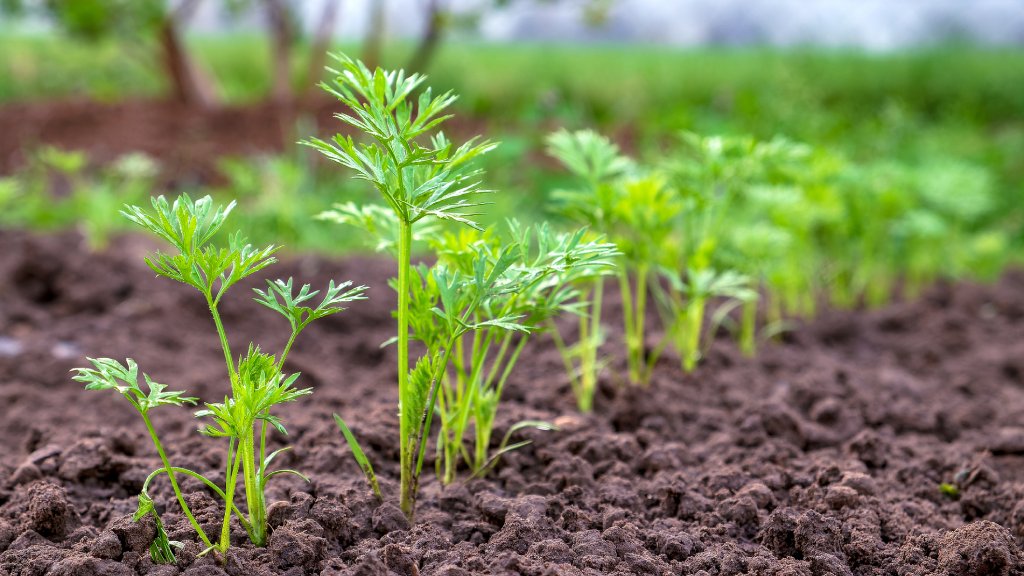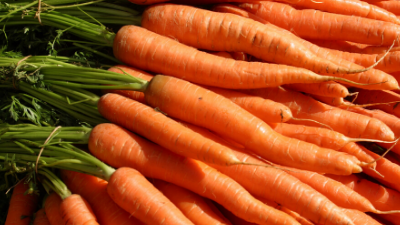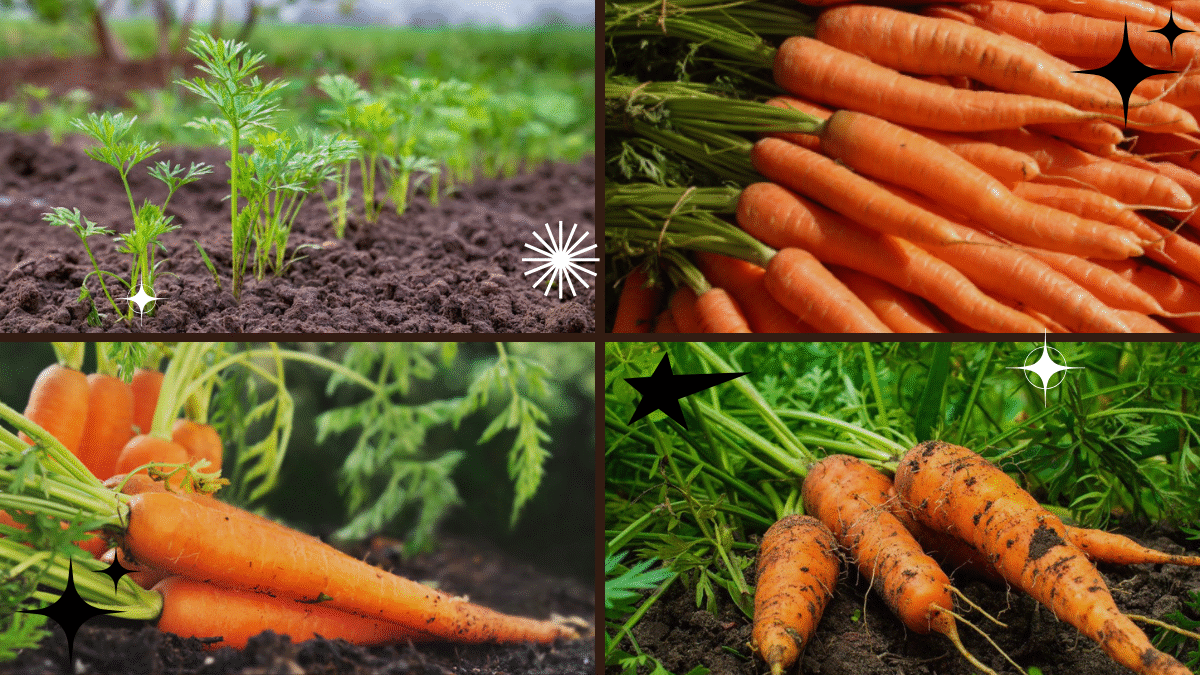Carrots are one of the most satisfying vegetables to grow in your home garden. Not only are they nutritious, versatile, and delicious, but watching those vibrant green tops rise above the soil while crunchy orange roots develop underground is a rewarding experience. The best part? You can start your carrot-growing adventure either from seeds or from leftover carrot tops!
In this comprehensive guide, we’ll show you exactly how to grow a carrot plant from both seeds and tops, including step-by-step instructions, care tips, and common mistakes to avoid. Whether you’re working with a spacious garden bed, raised planter, or a container on your patio, carrots are a fantastic, beginner-friendly crop to try.

Why Grow Carrots at Home?
Homegrown carrots often taste sweeter and fresher than store-bought varieties. You also get the freedom to grow unique heirloom or colorful varieties — from classic orange to purple, yellow, and even white.
Benefits of growing carrots:
- Fresh, chemical-free produce
- Fun for kids and beginner gardeners
- Can be grown in-ground, raised beds, or containers
- Options to regrow plants from kitchen scraps (tops)
Best Varieties to Grow
Carrots come in different sizes, colors, and shapes. Some popular and beginner-friendly varieties include:
- Nantes: Sweet, crisp, and cylindrical
- Danvers: Tapered, traditional orange carrots
- Chantenay: Short and fat — ideal for containers
- Purple Haze: Unique purple skin with orange flesh
- Little Finger: Small, tender carrots perfect for snacking
Choose a variety based on your soil type, available space, and growing conditions.

How to Grow Carrots from Seeds
Growing carrots from seeds is the traditional and most reliable method. Here’s a detailed, step-by-step guide:
Step 1: Choose the Right Spot
Carrots thrive in full sun (at least 6-8 hours daily) and loose, well-drained soil. Avoid heavy clay or rocky soil, as it can lead to deformed roots.
Tip: If your soil is heavy, grow shorter varieties like Chantenay or Little Finger in raised beds or deep containers.
Step 2: Prepare the Soil
Carrots prefer slightly acidic to neutral soil (pH 6.0-6.8). Loosen the soil at least 12 inches deep and remove any rocks or clumps. Mix in compost for added nutrients but avoid fresh manure, which can cause roots to fork.
Step 3: Sow the Seeds
- Timing: Carrots are a cool-season crop. Sow seeds outdoors 2-4 weeks before the last frost in spring or in late summer for a fall harvest.
- Spacing: Sow seeds about ¼ inch deep and 1 inch apart in rows 12-18 inches apart.
- Lightly cover seeds with soil and gently water.
Tip: Carrot seeds are tiny and slow to germinate, often taking 14-21 days. Keep the soil consistently moist during this time.
Step 4: Thin the Seedlings
Once seedlings are about 2 inches tall, thin them out to one plant every 2-3 inches. This ensures each carrot has space to develop properly.
Bonus Tip: Use small scissors to snip off extra seedlings at soil level instead of pulling them to avoid disturbing neighboring roots.
Step 5: Watering and Care
Carrots need consistent moisture, especially while roots are forming.
- Water deeply once or twice a week, ensuring soil stays evenly moist but not soggy.
- Mulch around the plants to retain moisture and reduce weed growth.
Step 6: Harvesting
Carrots are typically ready for harvest 60-80 days after sowing, depending on the variety. You’ll notice the shoulders of the carrot slightly poking out of the soil when they’re mature.
Harvest Tips:
- Loosen soil around the carrot before pulling to prevent breakage.
- Don’t leave them in the ground too long, or they may become woody.

How to Grow Carrots from Tops
Did you know you can regrow carrot greens from leftover tops? While this won’t produce new roots, the lush greens are attractive, edible, and perfect for garnish or pesto.
Step 1: Save the Top
After using the edible root, save about 1 inch of the carrot top.
Step 2: Start in Water
- Place the carrot top cut-side down in a shallow dish with about ½ inch of water.
- Set the dish on a sunny windowsill.
- Change the water daily to keep it fresh.
Step 3: Watch It Grow
Within a few days, you’ll see new green leaves sprouting from the top and small white roots forming at the base.
Step 4: Transfer to Soil
After 7-10 days, plant the sprouted top in a pot or garden bed with well-drained soil.
- Bury it so just the leaves remain above the surface.
- Water gently and keep the soil moist.
Note: While this method won’t regrow a new carrot root, it makes a lovely decorative herb-like plant, and the greens are edible.

Common Carrot Growing Problems (and Solutions)
- Poor Germination: Carrot seeds are slow starters. Keep soil consistently moist and consider covering with a thin board or shade cloth until they sprout.
- Deformed Carrots: Caused by rocky or compacted soil. Always loosen soil and remove debris before planting.
- Pests: Watch for carrot rust flies and aphids. Use row covers and companion plant with onions or garlic to deter pests.
- Splitting: Caused by irregular watering. Maintain consistent soil moisture.
Tips for Growing Carrots in Containers
If you have limited space, you can successfully grow carrots in containers.
- Choose a pot at least 12 inches deep.
- Use loose, well-draining potting soil.
- Sow seeds thinly and follow the same care guidelines as for garden planting.
Ideal varieties for containers: Chantenay, Little Finger, or Nantes.
Fun Ways to Use Carrot Greens
Don’t toss those carrot tops! While slightly bitter raw, they’re packed with nutrients and flavor.
- Pesto: Blend with garlic, olive oil, nuts, and lemon.
- Soup stock: Adds depth to vegetable broth.
- Herb substitute: Chop and sprinkle over salads, roasted veggies, or pasta.
Final Thoughts
Whether you start from seeds or regrow the tops, growing carrot plants is an easy and gratifying gardening project. With a little patience and care, you’ll soon enjoy fresh, crunchy, homegrown carrots — and a charming green addition from regrown tops.
Perfect for beginner gardeners, families, or anyone looking to dip their toes into homegrown produce, carrots are a must-have in your edible garden. Plus, the joy of pulling a fresh carrot from the soil is a simple, unbeatable pleasure.





Leave A Comment